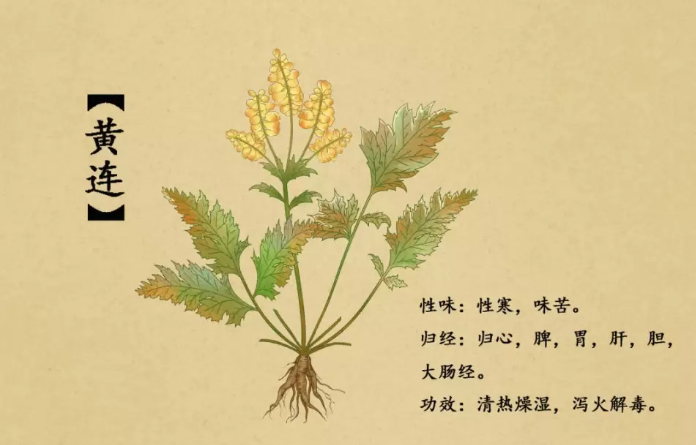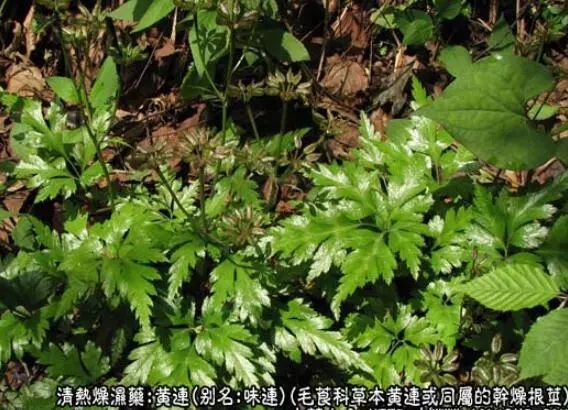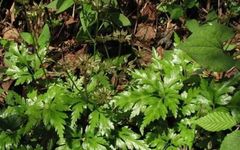
【Source】Huang Lian (Coptis chinensis Franch) is the dried underground rhizome of the perennial herbaceous plant from the Ranunculaceae family, cultivated or wild.
【Alias】Chuan Lian, Zhi Lian, Yun Lian, Ya Lian, Wei Lian
【Production Area】Chuan Lian (Wei Lian): Mainly produced in Shizhu County, Kaixian, Wushan, Wuxi, Enshi in Hubei, Lichuan, Laifeng, Jianshi, Xuan’en, Fangxian, and Zhuxi counties. All are cultivated.
Ya Lian: Mainly produced in the Emei Mountain area of Sichuan, along the Dadu River, in Leshan, Ya’an, and other places. Both cultivated and wild varieties exist.
Yun Lian: Mainly produced in Weixi, Deqin, Tengchong, and Bijiang in Yunnan Province. Both wild and cultivated varieties exist.
Additionally, Hunan, Guizhou, Shaanxi, Zhejiang, Anhui, Jiangxi, and other provinces also have introduced and wild varieties, but the yield is not large. Imported Huang Lian is mainly produced in Japan.
【Properties and Channels】Bitter and cold, enters the Heart, Liver, Gallbladder, Spleen, Stomach, and Large Intestine meridians.
【Functions and Indications】Huang Lian has the effects of clearing heat and drying dampness, purging fire and detoxifying. It is a strong bitter and cold herb, particularly effective in clearing damp-heat from the middle jiao, purging excess fire from the Heart channel, and is commonly used for damp-heat distension, vomiting with sour regurgitation, irritability and insomnia, carbuncles and sores, and damp-heat diarrhea.
【Dosage】Generally taken as a decoction, or in pills or powders. The decoction dosage is 2-5 grams.
【Precautions】This herb is very bitter and cold; excessive or prolonged use can harm the Spleen and Stomach. It is contraindicated in those with Spleen and Stomach deficiency-cold; caution is advised for those with Yin deficiency and fluid damage due to its bitter and drying nature.
【Harvesting and Storage】Huang Lian is harvested in October to November, 5-6 years after planting. The rhizomes are pulled up, dirt is shaken off, and the fibrous roots and leaves are trimmed. The rhizomes are then dried on a drying bed, turning them frequently and removing any dried soil. When they are 50-60% dry, they are sorted into 3-4 grades based on size, and further dried until the cross-section appears dry and straw-colored. They are then stored in containers, with soil and fibrous roots removed. Each hectare can yield 1500-2250 kg of dried Huang Lian.
【Identification】Chuan Lian (Wei Lian) rhizomes are often shaped like chicken feet, curved and branched, forming bundles or clusters, with some single branches. They are about 3-7 cm long, single branches 3-9 cm, and 3-8 mm in diameter. The surface is yellow-brown or green-brown, rough with many tubercles, and retains some fibrous roots and remnants. The upper part has scale-like leaf stalk remnants, and some have a smooth section in the middle, about 1-4 mm in diameter, varying in length, dividing the tuberous rhizome into two segments, commonly referred to as “crossing the bridge” or “crossing the river branch.” The texture is solid and hard. The cross-section is uneven, with a dark brown cortex, orange pith, and yellow or orange-yellow wood, often showing a chrysanthemum heart pattern, occasionally hollow, with cracks in the wood. The aroma is faint, and the taste is extremely bitter. The best quality is characterized by thick, less hairy branches, and a red-yellow cross-section.
Ya Lian (cultivated variety): The rhizomes are mostly single branches, rarely branched, slightly cylindrical, slightly curved, 5-10 cm long, and 3-10 mm in diameter. The surface is gray-brown, with many transverse markings, and fewer “crossing the river branches” than Chuan Lian. The cross-section is yellow, with a distinct chrysanthemum heart, often hollow. Wild varieties often retain 7-10 cm leaf stalks as a marker. The rhizomes are also mostly single branches, slightly curved, resembling silkworms, generally 2-4 cm long, about 6 mm in diameter. The skin is fine, brown, and the growth years often show scale-like nodes, commonly referred to as “fish scale armor.” The texture is solid. The cross-section shows a distinct yellow chrysanthemum heart, often hollow. (This variety is often exported and rarely sold domestically). The aroma and taste are similar.
Only those that are robust, without fibrous roots, and resembling silkworms are considered the best.
Yun Lian: The rhizomes are mostly single branches, often slender, curved and constricted, with closely spaced nodes, resembling scorpions. They are about 3-7 cm long, with a diameter of about 3 mm, with some larger ones reaching 0.8 cm in diameter. The surface is yellow-green or seven-yellow. The texture is solid and slightly brittle, with a golden-yellow cross-section, similar to Huang Lian.Only those that are robust, without hairs, and golden-yellow are considered the best.
Imported Huang Lian: The shape and color are similar to Yun Lian, but with more branches, the branches are slightly longer and thicker, and there are also more “crossing the river branches.” The texture is solid, with a yellow or orange-yellow cross-section, showing hollowness, and the aroma and taste are similar to Yun Lian.

【Cultivation Techniques】
1. Site Selection
Select a planting site with deep, loose, fertile soil, rich in humus, strong drainage, and good permeability.
2. Sowing and Transplanting
1. Dig 130 cm wide beds with 30 cm wide intervals, ensuring the bed surface is flat and arched. Mix stored seeds with 20-30 times humus soil and evenly sprinkle them on the bed surface, then add some cow dung powder or wood ash as base fertilizer. When the seedlings have 3 leaves, apply diluted manure water or a 1:1000 urea solution for weeding and fertilization.
2. Transplant in the spring of the second year after emergence, clearing the soil surface of residual branches, fallen leaves, stones, and roots from bamboo, small trees, and grasses. Transplant at a spacing of 10 cm and a depth of 3-5 cm.
3. Field Management
1. One month after rooting, apply 7.5-10 kg of ammonium sulfate per mu, and in October-November, apply 30,000-37,500 kg of well-rotted cow and horse manure per mu. Initially, focus on nitrogen fertilizer, then apply a thin layer of ash soil later. Fertilize each spring and autumn. In spring, apply 112.5-150 kg of ammonium sulfate or 15,000-22,500 kg of well-rotted manure or humus, and in winter, apply 37,500-60,000 kg of well-rotted cow and horse manure or cake fertilizer, calcium phosphate, and lime, ensuring to cover the soil after winter fertilization. After 3-4 years, reduce or stop nitrogen fertilizer, focusing on phosphorus and potassium fertilizers, and avoid fertilizing before harvest.
2. Keep the bed surface free of weeds, removing them early and when small; water frequently in summer to maintain soil moisture.
3. Powdery mildew often occurs on newly planted Huang Lian, starting as white powder and later becoming water-soaked, with leaves gradually turning dark red-brown. After onset, irrigate with pig manure water to increase nutrition and promote greening, then spray with 0.3-0.5 Baume degree lime-sulfur mixture for prevention and treatment; zinc phosphide mixed with corn flour in a 1:20 ratio can be used as bait in the fields or mouse holes to prevent rodents.
Source: Comprehensive Knowledge of Chinese Herbal Medicine

Source: This article is for non-commercial use only, reprinted solely for the dissemination of basic knowledge about Chinese medicinal materials and positive energy in the industry. If there are any objections, it will be deleted. The views expressed in this article are solely those of the author and do not represent the position of this platform. Please indicate the source when reprinting.


Quality of Medicinal Materials
Quality of Medicine
Scan to View
More Content

